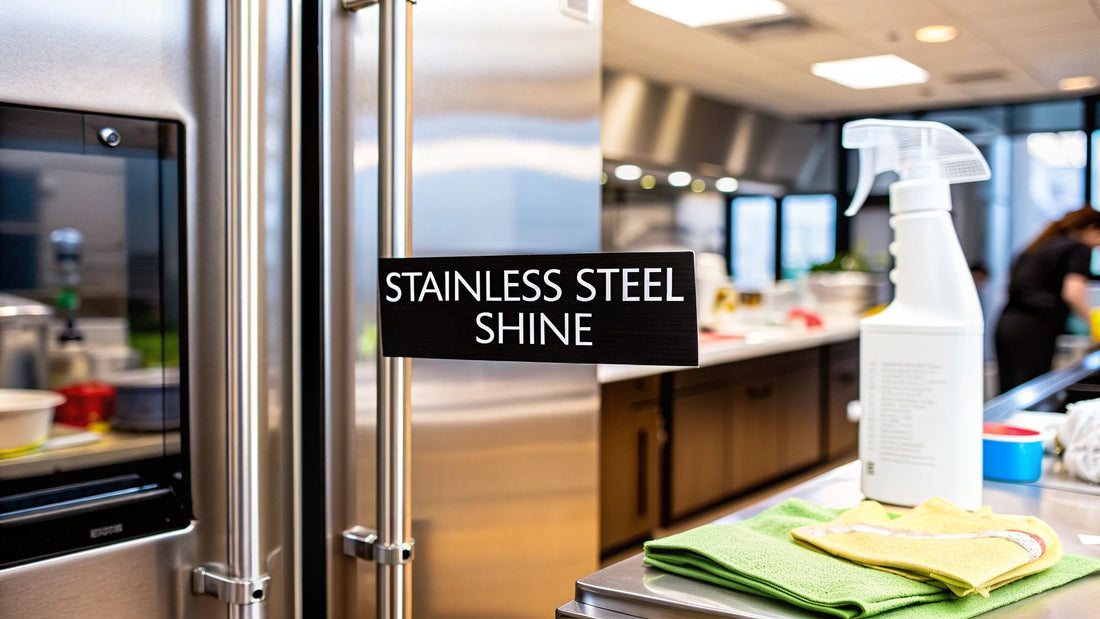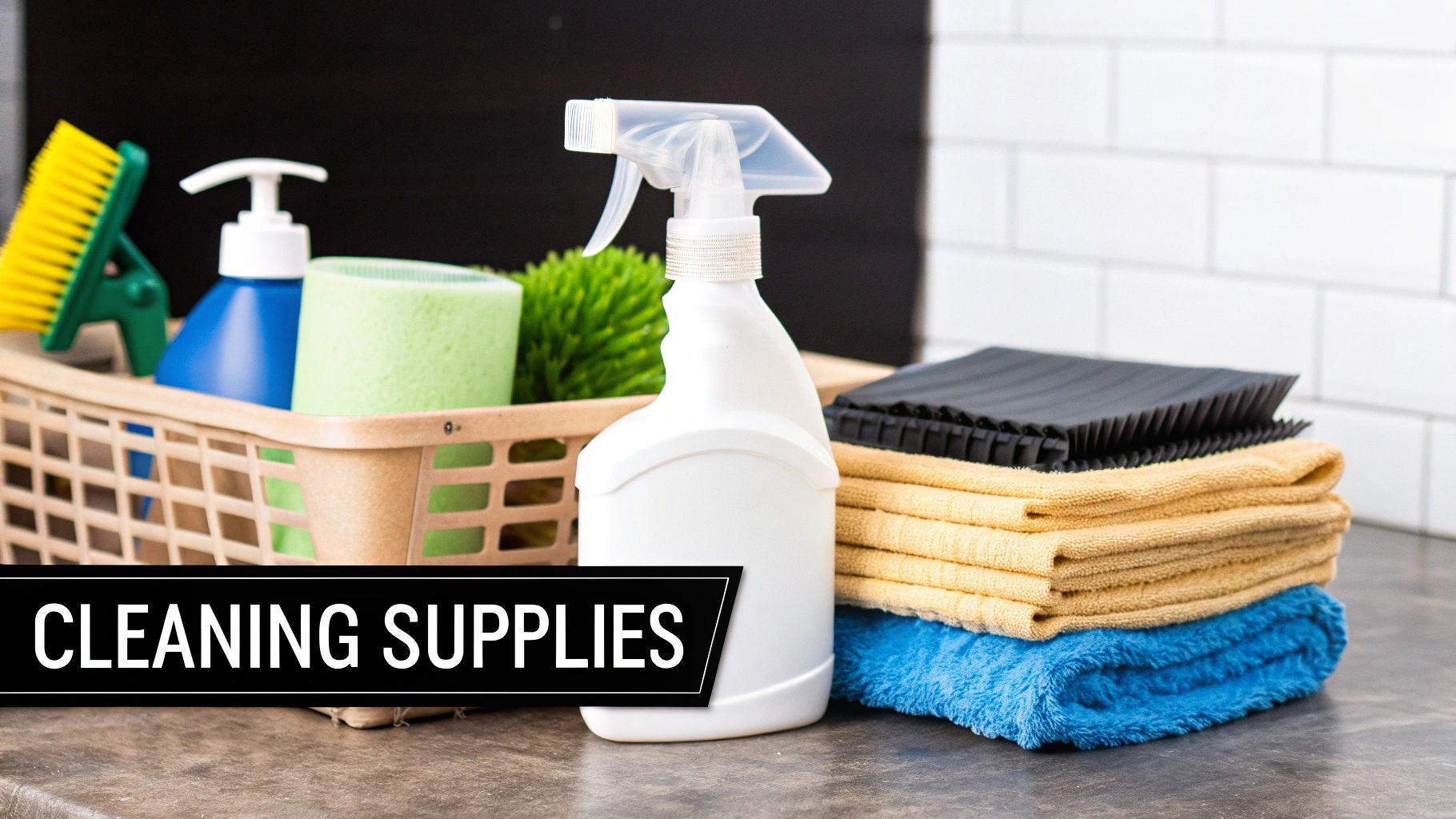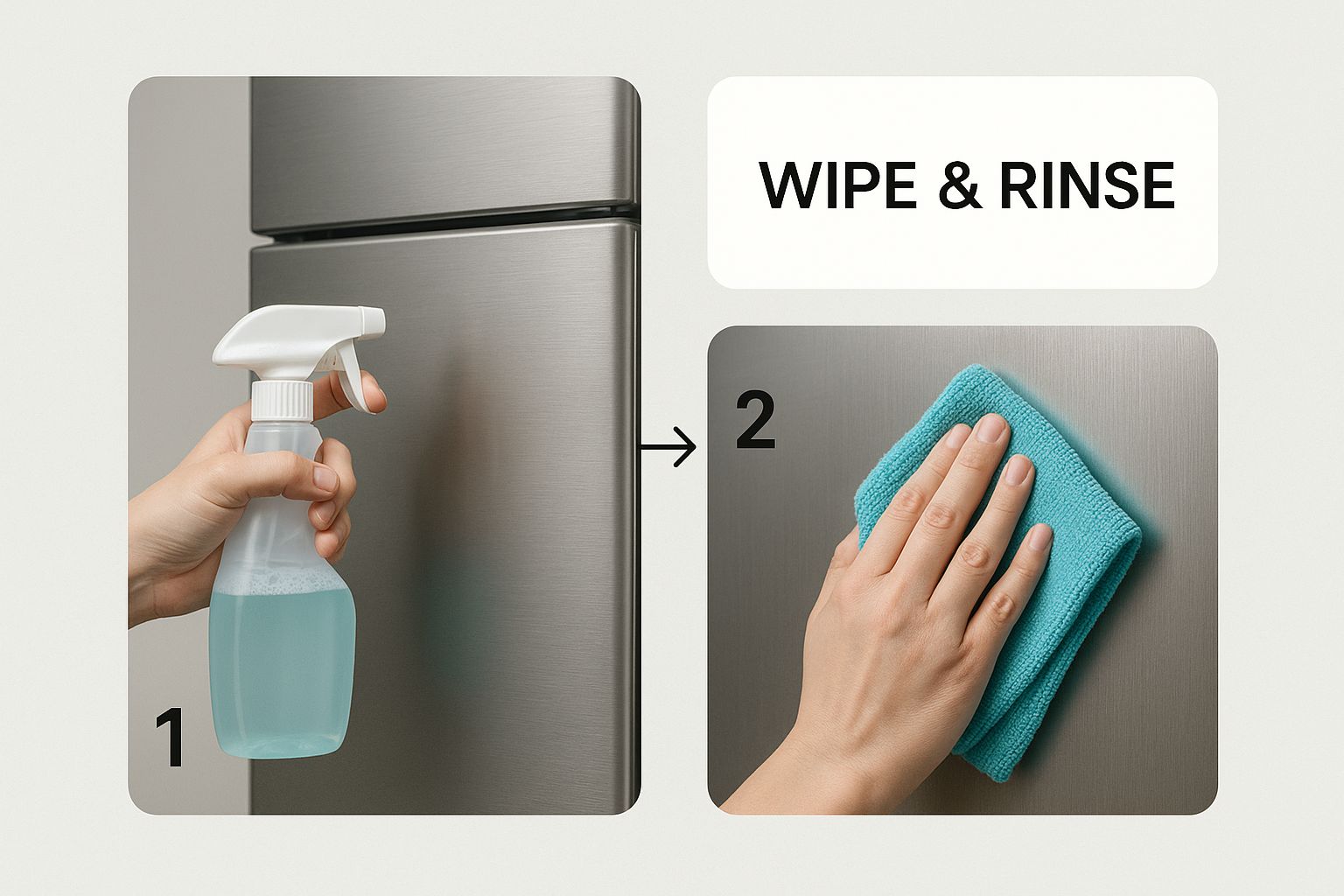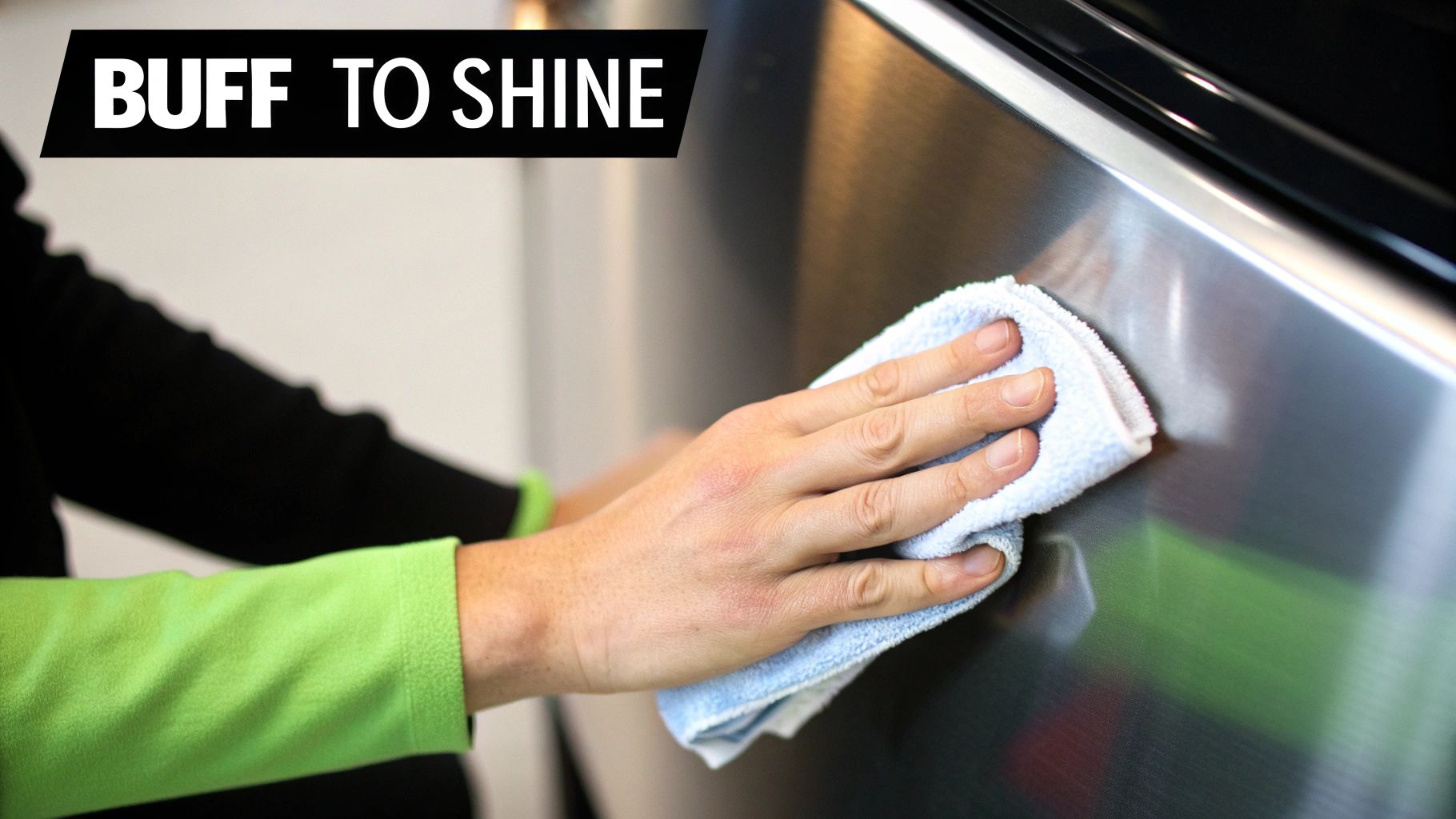
Best Way to Clean a Stainless Steel Pizza Prep Table
Share
When you run a pizzeria, knowing the best way to clean a stainless steel refrigerator goes way beyond just making it shine. Sure, using food-safe degreasers and wiping with the grain is the right technique, but the real importance is what that clean surface represents: a rock-solid commitment to quality and safety.
Honestly, it’s a secret ingredient that can make or break your restaurant's success.
Why a Clean Pizza Prep Table Is Your Pizzeria's Secret Ingredient
In the controlled chaos of a busy pizza kitchen, your stainless steel pizza prep table is the heart of the whole operation. It isn't just a piece of equipment; it's command central for every pizza you make. A gleaming, well-maintained surface isn't just nice to have—it's a non-negotiable that affects everything from food safety to what your customers think of you.
Think of it as the very first layer of quality control before a single ounce of dough is even touched.

This dedication to cleanliness has a direct impact on your reputation. If you have an open kitchen, your entire pizza-making process is on display. Trust me, customers notice the little things. A spotless stainless steel prep table screams professionalism and shows you care, building trust before they’ve even had a slice.
The Unique Mess of a Pizza Kitchen
Let's be real—a pizzeria is a special kind of messy. Standard cleaning tricks that work in other kitchens just don't cut it here. Your pizza prep tables face a daily barrage of specific ingredients that need a targeted cleaning strategy. A quick wipe-down won't do the job.
You're up against some unique challenges:
- Fine Flour Dust: It gets absolutely everywhere. When it mixes with condensation from your refrigerated prep table, it creates a stubborn, pasty gunk that’s a pain to scrub off.
- Acidic Tomato Sauce: Those inevitable splatters can actually etch the surface of the steel if you let them sit. This leads to ugly discoloration and can even cause corrosion over time.
- Greasy Cheese and Meats: Oily residue from pepperoni, sausage, and cheese builds up into a sticky film that becomes a magnet for every other bit of grime in the kitchen.
A pristine prep station isn't just for show. It's a cornerstone of your kitchen's food safety plan, preventing cross-contamination and keeping every ingredient fresh and safe for your customers.
It's About More Than Just Looks
Beyond making a good impression, a clean pizza prep table is crucial for keeping your kitchen running smoothly and safely. Sticky, grimy surfaces will slow down your prep line, and old food particles are a breeding ground for bacteria.
Maintaining a sanitary environment isn't just good practice—it's your legal and ethical duty. To really nail this down, it’s worth reviewing the essential food safety guidelines for restaurants to make sure your kitchen is operating above and beyond industry standards.
A clean workspace empowers your team to work efficiently and safely, which is the bedrock of any great pizzeria. At the end of the day, understanding the best way to clean a stainless steel pizza prep table means recognizing it as a core business function, not just another chore on the list.
Assembling Your Food-Safe Cleaning Toolkit
Having the right tools on hand makes all the difference between a frustrating chore and getting that perfect, streak-free finish on your stainless steel pizza prep table. We're not talking about generic, all-purpose stuff here; a pristine pizza kitchen needs a dedicated arsenal built for efficiency and, most importantly, food safety. The goal is a sanitary, impressive-looking prep surface without accidentally damaging that beautiful stainless steel.
The absolute foundation of your toolkit is what you use to wipe things down. For stainless steel, microfiber cloths are the undisputed champs. I can't stress this enough. Their tiny fibers are incredible at grabbing onto flour dust, grease, and smudges without leaving lint behind. Crucially, they won't cause the microscopic scratches that can dull your prep table's finish over time.
Choosing Your Cleaning Solution
Once you have your cloths, you need to decide what you're cleaning with. You really have two solid paths here: a trusted commercial cleaner or a simple, effective DIY solution. Both have their place, and frankly, the best choice often just depends on the kind of mess you're dealing with at the end of a shift.
Here’s a quick look at your best bets:
- Commercial Cleaners: These are a great option because they're specifically formulated for stainless steel. Always look for products that are NSF-certified or clearly labeled as food-safe. They're fantastic at cutting through stubborn grease from cheese and meats and often contain a polishing agent that helps repel future fingerprints.
- DIY Vinegar Solution: A simple mix of equal parts white vinegar and water in a spray bottle is a powerhouse for daily cleanups. It’s completely food-safe, costs next to nothing, and does a great job cutting through light grime and sanitizing surfaces.
- Warm, Soapy Water: Never underestimate this classic. A bit of mild dish soap in warm water is perfect for that initial wipe-down to get rid of loose flour, toppings, and sauce spills before you do a deeper clean or polish.
It might sound too simple, but this last one is incredibly popular for a reason. Recent surveys show that about 68% of stainless steel owners rely on just warm, soapy water and microfiber cloths for their regular cleaning. And the popularity of microfiber itself has exploded, with sales jumping over 40% in the last five years because of how gently—yet effectively—it cleans.
Key Takeaway: For any pizzeria, food safety has to be the top priority. Whatever cleaner you choose, whether it's store-bought or homemade, it must be approved for food-contact surfaces to avoid any risk of chemical contamination.
Building Your Complete Arsenal
Beyond cloths and sprays, a few extra items will round out your kit and have you ready for anything. It’s also worth thinking about how your supplies impact your equipment and your staff. For example, when it comes to sanitizing, it’s vital to understand the different types of sanitizer solutions available for a food-safe environment.
If sustainability is a priority for your pizzeria, there are some fantastic options out there. As you're choosing safe cleaning agents for your prep table, it can be helpful to consult a guide on the best eco-friendly cleaning products. Having a well-stocked and thoughtful toolkit means you're always prepared.
The Pro Cleaning Method for Pizza Prep Tables
In a busy pizzeria, that end-of-shift cleanup has to be a well-oiled machine. It’s got to be fast, effective, and completely foolproof. This isn't just about a quick wipe-down; it's a proven protocol that keeps your kitchen sanitary and your stainless steel pizza prep table looking like it was just unboxed. The whole process starts with smart prep work before a single drop of cleaner hits the surface.
First things first: clear the decks. Get all the dough trays, ingredient bins, and any stray pizza peels off the prep table. This simple step gives you a clean shot at every corner and, just as importantly, prevents cross-contamination. Make sure you're storing those ingredients properly in the refrigerated base while you clean—that's half the battle right there.
The Two-Phase Clean and Polish
Want to know the real secret to a professional finish on your pizza prep table? It's a two-step approach: a deep clean followed by a protective polish. This dual-phase method is what separates a decent-looking kitchen from a truly impressive one. You're not just moving grime around; you're dissolving it, then restoring the steel's natural shine.
Phase One: The Deep Clean
This is where you tackle the day's mess head-on—the crusted-on tomato sauce, greasy cheese residue, and that fine layer of flour dust that gets everywhere. Your best tool for this job is a good food-safe degreaser or even a strong vinegar-and-water solution.
- Spray your chosen cleaner generously over the entire stainless steel surface.
- Now, let it sit. Give it a few minutes to penetrate and dissolve the stubborn, caked-on messes. Don't rush this part. Letting the cleaner do the heavy lifting saves you from aggressive scrubbing later.
- Grab a clean, damp microfiber cloth and wipe everything down. Technique really matters here.
The right motion for wiping and rinsing your stainless steel is key to avoiding streaks.

As you can see, a simple wipe-and-rinse process is what delivers that flawless, professional gleam on your pizza prep equipment.
Phase Two: The Protective Polish
Once the surface is sparkling clean and—this is crucial—completely dry, it's time to polish. This step isn't just for aesthetics. It creates a microscopic barrier that helps repel fingerprints, water spots, and future sauce splatters, which makes your next cleanup a whole lot easier. A quality stainless steel polish or a little bit of food-grade mineral oil works perfectly.
Always Wipe With the Grain: This is the golden rule of stainless steel care. If you look closely at your prep table, you'll see very fine lines running in one direction. Wiping parallel to these lines is the single most important technique for preventing streaks and getting a seamless shine.
Daily vs Weekly Cleaning for Your Pizza Prep Table
To keep things manageable, it helps to distinguish between the quick end-of-shift tasks and the more thorough deep cleaning your stainless steel requires. This quick guide breaks it down.
| Task | Daily Routine (End of Shift) | Weekly Deep Clean |
|---|---|---|
| Surface Wipedown | Yes, with a food-safe cleaner to remove fresh spills, flour, and debris. | Yes, a more thorough cleaning with a degreaser to remove buildup. |
| Remove Bins/Trays | Yes, to clean the surface underneath. | Yes, and the ingredient bins themselves should be deep-cleaned and sanitized. |
| Polish | No, not typically necessary every day. | Yes, after deep cleaning and drying to protect the surface. |
| Check Gaskets | Quick visual check for major debris in the refrigerated base. | Wipe down gaskets with a damp cloth to remove grime and maintain a good seal. |
Following this schedule ensures your pizza prep table is always ready for service and meets health code standards without requiring a massive cleaning project every single day.
Natural Solutions for a Brilliant Finish
While commercial products get the job done, some of the best methods use simple, food-safe ingredients you probably already have in your pizzeria. Research on household cleaning consistently points to one standout natural combo for both cleaning and polishing stainless steel: vinegar and olive oil.
This mixture is highly recommended for its amazing ability to cut through grime and leave behind a brilliant, protective shine that minimizes fingerprints and water spots. With the growing demand for non-toxic cleaning alternatives, this method is both incredibly effective and environmentally friendly. You can learn more about how simple ingredients can transform your appliance care by exploring these effective natural cleaning techniques.
By sticking to this proven two-phase process, your pizzeria's prep table won't just meet health standards—it will stand as a shining example of your commitment to quality.
Avoid These Common Stainless Steel Cleaning Mistakes
In a busy pizzeria, it's easy to grab the nearest heavy-duty cleaner to deal with a mess on the prep line. But when you're working with your stainless steel pizza prep tables, that shortcut can turn into a very expensive mistake. These surfaces are built to last, but they're not invincible, and the wrong chemicals or tools can cause permanent damage.
Frankly, knowing what not to do is just as important as knowing the right way to clean. It's all about protecting your investment for the long haul.

The Scratch Test You'll Always Fail
The single most common mistake I see pizzeria staff make is reaching for something abrasive. Think steel wool, scouring pads, or gritty cleansers. While they might seem like a great idea for scrubbing off baked-on cheese or dried tomato sauce, they will absolutely destroy your stainless steel finish.
These tools leave a web of scratches that don't just look awful; they create tiny crevices where bacteria can thrive. Once that smooth surface is scratched, it becomes much harder to sanitize properly, which can quickly become a food safety hazard right where you build your pizzas.
My rule of thumb: If a cleaning tool feels rough in your hand, it's definitely too rough for your stainless steel. Always stick with microfiber cloths or soft sponges to keep that surface smooth and easy to clean.
The Chemical Reaction You Don't Want
Another huge no-no is using cleaners that contain chlorine, especially bleach. Bleach is a fantastic disinfectant for many things, but it's public enemy number one for stainless steel. Chlorine-based chemicals trigger a reaction called pitting corrosion, which eats tiny, pinhole-sized rust spots into the surface.
This isn't just a cosmetic problem. Over time, those little pits can deepen and weaken the steel itself, leading to irreversible damage. Many oven cleaners and even some sanitizers contain harsh chemicals that do the same thing, so get in the habit of reading the label before you spray anything on your pizza prep table.
Damaging the Protective Layer
What makes stainless steel so durable is a very thin, invisible layer of chromium oxide that naturally forms on its surface. This "passive layer" is what shields the metal from rust and corrosion.
According to the American Cleaning Institute, letting dirt and grime from pizza ingredients build up can actually stop this protective process from happening, trapping corrosive stuff right against the metal. Using abrasive cleaners physically wears this layer away, leaving your expensive equipment vulnerable.
Good preventative maintenance doesn't just keep your equipment looking glossy; it can cut your long-term expenses by up to 20% compared to dealing with neglected appliances. By steering clear of these common pitfalls, you’re doing more than keeping your pizza prep table looking new. You're making sure it remains a hygienic, durable, and reliable part of your kitchen for years.
Maintaining a Lasting Shine and Food-Safe Finish
Getting your stainless steel pizza prep table sparkling clean is a great start, but in a busy pizzeria, that's only half the battle. The real secret is a smart maintenance routine that keeps it looking that way, day in and day out. Thinking ahead saves you from heavy-duty scrubbing later and protects your investment for the long haul.
It’s all about shifting from reactive deep cleans to proactive daily care. The best thing you can do is create a protective barrier that repels all the fingerprints, sauce splatters, and flour dust that are inevitable in a pizza kitchen. This one simple step can shave a surprising amount of time off your end-of-night cleanup.
Creating a Protective Barrier
Once your prep table is perfectly clean and dry, the final touch is applying a protective finish. This isn't just about aesthetics; it creates a microscopic shield that makes it incredibly difficult for grease and grime to get a foothold on the surface.
You've got a couple of great, food-safe options for this:
- Food-Grade Polish: A high-quality commercial stainless steel polish is your best bet. It’s formulated to create that perfect, uniform shine while leaving behind a protective film. You only need a tiny amount on a microfiber cloth.
- Mineral Oil: Don't overlook this simple solution. A thin layer of food-grade mineral oil does an amazing job. It evens out the finish, helps mask any tiny scratches, and provides a solid barrier against moisture and smudges.
This finishing touch is what separates a clean prep table from a professionally maintained one. It ensures your equipment looks fantastic and, more importantly, makes it easier for your crew to keep it that way, which keeps your kitchen running smoothly.
The Power of a Daily Wipe-Down Routine
In a pizzeria, consistency is everything. A quick, mandatory wipe-down at the end of every shift is the single most effective thing you can do. This simple habit, which takes just a couple of minutes, prevents flour paste and sauce from cementing onto the surface overnight. Make it a non-negotiable part of your closing checklist.
The routine is as simple as it gets:
- First, clear everything off the surface.
- Give it a quick spray with a mild, food-safe cleaner (a simple vinegar and water mix works great).
- Wipe it down with a clean microfiber cloth, always following the grain of the steel.
- Finally, buff it dry with a separate, dry cloth to banish any potential water spots.
This process quickly removes any corrosive food acids or oils before they can even think about causing damage. For pizzeria owners outfitting their space, knowing how to care for different surfaces is key. You can find more on the durability and upkeep of various commercial stainless steel tables to help you make the right choices for your kitchen layout.
Spotting Trouble Before It Starts
Good maintenance isn't just about cleaning; it's also about being observant. Train your team to keep an eye out for the early warning signs of trouble. This means spotting and reporting little issues like tiny rust spots—often caused by a wet sauce can left sitting too long—or the first hints of pitting on the surface.
Catching these problems early makes all the difference. You can usually tackle a small rust spot with a simple paste of baking soda and water, stopping it from becoming a much bigger, more costly headache. For a broader look at keeping various kitchen surfaces in top shape, these general care and cleaning tips are a fantastic resource. By making proactive care a priority, you ensure your stainless steel equipment remains a point of pride that reflects your pizzeria’s commitment to quality.
Got Questions? I've Got Answers
When you're in the weeds during a dinner rush, the last thing you want to worry about is how to clean your stainless steel prep table. Over the years, I've heard the same questions from pizzeria owners time and time again. Let's get them answered so you can get back to making great pizza.
How Often Should I Really Deep Clean My Pizza Prep Table?
Look, a quick wipe-down every day is non-negotiable. That's just basic food safety to get rid of cheese shreds, sauce splatters, and stray toppings.
But for a real deep clean—the kind that gets all the grease and caked-on flour dust—you need to be doing it at least once a week. In a busy pizzeria, that combination of flour, oil, and moisture creates a stubborn film that can make your whole prep line feel sticky and slow.
A weekly deep clean isn't just about looking good. It’s about speed and safety. A sticky, grimy surface slows your crew down and becomes a perfect home for bacteria. Consistency is everything here.
Can I Just Use Disinfecting Wipes on My Pizza Prep Table?
I'd be careful with those. It really comes down to what's in the wipe. Many of the big-name disinfecting wipes you grab at the grocery store have bleach, ammonia, or citrus-based cleaners in them. Over time, those chemicals can strip the protective layer right off your stainless steel, leaving behind ugly streaks, dull spots, or even causing it to corrode.
Your best bet? Stick with a food-grade sanitizer that’s specifically made for stainless steel. If you don't have that on hand, a little mild dish soap and warm water followed by a good rinse with plain water works perfectly for daily cleaning. Just be sure to check the label on any cleaner to make sure it's safe for food-contact surfaces.
What’s the Secret to Getting Rid of Dried-On Tomato Sauce?
Whatever you do, step away from the metal scraper or steel wool! I’ve seen people scratch up a brand-new pizza prep table trying to chisel off old sauce. It's painful to watch.
The trick is actually in your pantry: baking soda.
- Mix up a thick paste, about the consistency of toothpaste, using baking soda and a little water.
- Slather that paste directly onto the crusty, dried-on sauce stain.
- Just let it sit there for about 20 minutes. Don't touch it. The paste does the work for you, breaking down the acids in the tomato.
- After 20 minutes, come back with a soft, damp cloth and gently wipe it away, always moving with the grain of the steel.
Rinse the spot with clean water and dry it completely with a microfiber towel. No more sauce stain, and more importantly, no new scratches.
Ready to stop fighting with old, worn-out equipment? If you're looking for gear that’s designed for the demands of a real pizzeria and is a breeze to maintain, check out the selection at Pizza Prep Table. You can find the perfect NSF-compliant refrigerated prep table for your kitchen at https://pizzapreptable.com.
